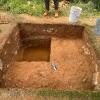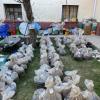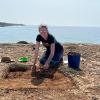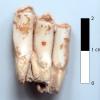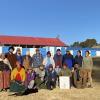Academic department of Anthropology
Taraco Archaeological Project
This research project involved travel to the community of Chiripa, Bolivia for the 2023 field season of the Taraco Archaeological Project. During the season, excavations were conducted at three sites in the Taraco Peninsula. Around 200 samples were processed via flotation, as well as about 60 which were processed via dry screening, yielding macrobotanical remains that were exported for anaysis at the McCown Archaeobotany Laboratory .
Ancient Seafaring Explorers of Cyprus: Coastal Cliffhangers of the Epipalaeolithic
The recent recognition of Late Epipalaeolithic sites on the Mediterranean island of Cyprus moves the date of early explorers to the island back at least 3000 years, changing our preconceptions about the nature of these first settling communities. Evidence at these early sites suggests that people were bringing plants and animals with them from the mainland (Simmons 1999), creating a sense of home in an unfamiliar landscape.
Geophysical Survey of a Choleric Mass Grave in San Juan, Puerto Rico
In 1855, Puerto Rico was struck by the cholera epidemic, killing 20,000 to 50,000 individuals – 4-10% of the total population at the time. Due to the high volume of corpses piling up and fear of the disease’s further spreading, a cemetery outside of the walls of El Morro was established. This cemetery remained untouched for over a century, due to fears that the disease might resurface. Today, however, this cemetery is in danger of being destroyed, as tourists in Old San Juan have been recently granted access to this section of the fort, uncovering human remains as they walk in the trail.
Gazelle Tooth Enamel Stable Isotope as a Paleoclimate Proxy at Kharaneh IV, Jordan
Oxygen and carbon isotopes extracted from gazelle tooth enamel are used to reconstruct the paleoenvironment during the occupation of Kharaneh IV
The Stahl Research Report is available on eScholarship.
Material Culture and Archaeology of Citizenship on the United States/Mexico Border
This work is based on my dissertation research which looks at the skeletal, material culture, and ethnographic evidence of structural violence in Latin America, and how this leads to immigration. Structural violence can be seen in these various avenues and used in conjunction with one another in providing a better framework that is not necessarily driven by the researcher’s interpretation but by the individuals who experienced this structural violence firsthand.
Reconstructing Animal, Plant, and Landscape Management Processes at the Onset of Food Production in the Lake Titicaca Basin
The Taraco Archaeological Project completed excavations during the summer of 2022 at the Formative site of Chiripa on the shores of Lake Titicaca. The focus was on early occupation seeking early farming evidence. They encountered these levels under historic hacienda deposits in four units. We had a great open day where all of the school children visited the laboratory and excavations.






